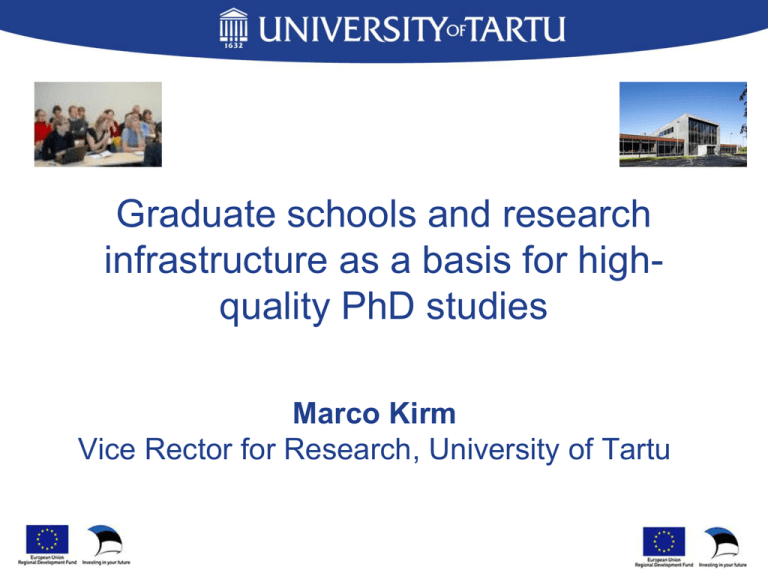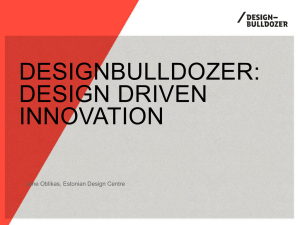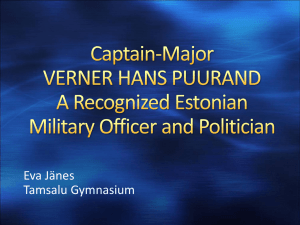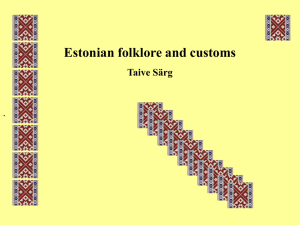Graduate schools and research infrastructure as a basis for high
advertisement

Graduate schools and research infrastructure as a basis for highquality PhD studies Marco Kirm Vice Rector for Research, University of Tartu Estonian R&DI Strategy 2007-2013 „Knowledge based Estonia“ The strategy sets out three main objectives: • competitive quality and increased intensity of research and development; • innovative enterprises creating new value in the global economy; • innovation friendly society aimed at a long-term development The objectives set in the strategy will be achieved through 4 activities: • development of human capital; • organising the public sector RD&I more efficiently; • increasing enterprises’ innovation capacity; • policy-making aimed at long-term development of Estonia. The strategic key technologies: information and communication technologies; • biotechnologies; • material technologies; Goal for 2015 300 PhDs yearly Strengthening the Baltic- Nordic research collaboration, 21.-23. May 2014 Tartu Estonian Innovation and Financing system in 2014 http://www.mkm.ee/eesti-innovatsioonisusteem/ Policies and strategies Development Fund ParlamentParliamen Academy of Sciences Government Research and Development Council Innovation Policy Committee Program Design Application of programs Projects Ministry of Economy and Communication Enterprise Estonia Enterprises Kredex Science and Technology parks Reserach Policy Committee Ministry of Science and Education Research Competence Council Estonian Research Council Competence Centres Archimedes Foundation Universities Innove R&D Organisations Programs -Estonian Research, Development and Innovation Strategy 2007-2013 Development of human rescources – programs (European Social Fund): • • • • • • • TULE – continuation of broken higher education (Bac., Ms. and PhD students) TeaME – science, media and we (society) PriMus- improving quality of higher education BeSt- program for developing e-education DoRa – PhD studies and Internationalization of higher education Mobilitas – mobility of scientists – to and from Estonia EduKo- support for educational sciences and teachers education Development of research infrastructures and equipment (European Regional Development Fund): • Small scale equipment – research group level – up to 60 k€ • Medium scale – institution level (University) – each project up to 1 278 k€ • Large scale - state level (Research Infrastructure Roadmap ) > 1 200 k€ http://www.hm.ee/index.php?148667 National Roadmap of Research Infrastructures in 2010, upgrade in 2014 1. Estonian e-Repository and Conservation of Collections 2. Estonian Centre for Genomics - BBMRI 3. Center of Estonian Language Resources –ELIXIR 4. Estonian Environmental Observatory 5. Estonian Beamline at MAX-IV Synchrotron Radiation Source 6. Estonian Magnet Laboratory (EML) 7. Estonia in European Social Survey 8. Estonian participation in the European Organization for Nuclear Research (CERN) 9. Estonian PET-Centre 10. Estonian Structural Biology Infrastructure (ESI) 11. Estonian Scientific Computing Infrastructure 12. Estonian Research and Education Optical Backbone Network 13. ESS - European Spallation Source - ESSS 14. Membership in the European Space Agency - ESA 15. Membership in the European Southern Observatory (ESO) 16. Natural History Archives and Information Network -NATARC 17. Baltic Sea Regional Research Vessel 18. Nanomaterials - Research and Applications-NAMUR 19. National Centre for Translational and Clinical Research - EATRIS 20. Plant Biology Infrastructure - from Molecules to Crops Strengthening the Baltic- Nordic research collaboration, 21.-23. May 2014 Tartu Courtesy of Priit Tamm, Estonian Research Council Strengthening the Baltic- Nordic research collaboration, 21.-23. May 2014 Tartu EU Funding (ESF 111.7 and ERDF 328.2 M€) • • • • Investments into research infrastructures State program for developing R&D infrastructure – 29.3 M€ (81 % - UT share) Internationalisation of Estonian R&D – 12.6 M€ Large scale equipment – 120.8 M€ (39 %) Equipment at research group level – 45.1 M€ (50 %) • • • • Human capital Center of Excellence program – 11 centers, 46.5 M€ (55 %) Graduate Schools Programme – 13 schools, 16 M€ (65 %) DoRa ( Int. of higher education) – 26.5 M€ (50 %) Mobilitas (Post Docs, Top Scientists) - 19.2 M€ (40 %) Research and Developement • R&D technology programs - 46.9 M€ (35 %) Strengthening the Baltic- Nordic research collaboration, 21.-23. May 2014 Tartu Chemicum 2009, Physicum 2014, SIME 2014 On roadmap:Nanomaterials - Research and Applications-NAMUR National Centre for Translational and Clinical Research Graduate School „Functional Materials and technologies“ Graduate School in Biomedicine and Biotechnology CoE: „Advanced materials for sustainable development“ „Mesosystems – theory and applications“ „Centre for nonlinear studies“ CoE: „Translational medicine“ „Estonian Centre for Genomics“ Estonian Finish beamline at MAX-IV, Lund Sweden European Spallation Source ; activities at CERN EATRIS ERIC BBMRI ERIC; ELIXIR ERIC Strengthening the Baltic- Nordic research collaboration, 21.-23. May 2014 Tartu Statistics on PhD studies in Estonia ca 1300 are involved to the graduate schools, 241 are from abroad (66) 57/43 % female/male , ca 400 starting every year no of doctoral programs: 167 70 ; no of students 12 43 http://www.haridussilm.ee/ Strengthening the Baltic- Nordic research collaboration, 21.-23. May Graduate Schools Graduate Schools were established in the framework of Estonia’s OP for Human Resource Development measure "Development of collaboration and innovation in higher education institutions", submeasure "Doctoral Schools", as financed by European Structural Funds. Each Doctoral School is an exclusive project for developing academic cooperation including universities or other relevant institutions. It aims to develop existing doctoral programs through various activities and projects attracting different supplementary resources. Strengthening the Baltic- Nordic research collaboration, 21.-23. May 2014 Tartu 13 Doctoral schools 2009-2015 ( 16.9 MEUR) • Graduate School in Biomedicine and Biotechnology (3/6/5)* • Estonian Graduate School in Mathematics and Statistics (3/3/6) • Graduate School in Civil and Environmental Engineering (3/8/7) • Doctoral School of Energy and Geotechnology (2/2/7) • Graduate school „Functional materials and technologies“ (2/1/1) • Doctoral School of Educational Sciences (2/1/1) • Doctoral School in Information and Communication Technology (2/2/2) • Graduate School of Linguistics, Philosophy, and Semiotics (2/1/1) • Doctoral School of Clinical Medicine (1/1/1) • Doctoral School of Behavioral, Social and Health Sciences (2/1/1) • Graduate School of Culture Studies and Arts (4/4/1) • Doctoral School of Earth Sciences and Ecology (4/2/6) • Doctoral School in Economics and Innovation (3/1/6) * Data source http://researchinestonia.eu/ Strengthening the Baltic- Nordic research collaboration, 21.-23. May 2014 Tartu Benefits of doctoral schools supplementary funds which enabled additional necessary activities which could have not been organised otherwise (for example, summer and winter schools, conferences, co-supervisors from abroad, etc.) enhanced collaboration between institutions, disciplines, sectors and countries, intensified mobility of PhD students improved communication between doctoral students, supervisors, teaching staff and coordinators of doctoral programmes adjustment of requirements and regulations among Estonian universities general movement towards more structured doctoral programmes. Accord. studies lead by Prof. Eamets „Efficiency of PhD studies“, 2014 under programme TIPS „Monitoring research and innovation polices“ and 2011 – „Report on graduate schools“ Strengthening the Baltic- Nordic research collaboration, 21.-23. May 2014 Tartu Bottlenecks of PhD studies in Estonia Policy makers • MOTIVATION – social and economic (higher income!) security + sufficient research funding + generally the status of PhDs in society Universities • CONDITIONS – high level supervising + sufficient rescources (funding, equipment, staff, cooperation …) + clear responsibilities and procedures Graduate schools have been great help for improving quality of PhDs, but not the quantity yet. This program will be continued in 2015. Strengthening the Baltic- Nordic research collaboration, 21.-23. May 2014 Tartu PhD degrees awarded in Estonia and at UT 300 250 250 233 190 200 175 163 161 153 150 114 100 96 90 06/07 07/08 101 95 50 0 09/10 10/11 11/12 12/13 Strengthening the Baltic- Nordic research collaboration, 21.-23. May 2014 Tartu Conclusions & Challenges • Modern competetive research infrastructure has been developed • Strong link to European activities incl. large scale facilities • Successful complex approach – people, infrastructure, R&D programs • Too many split programs – burden of bureaucracy at the use of SF • Additional „softer“ efforts for increasing number of PhD awarded • • • • Networking with other sectors (industry) and other countries Balance between national / EU structural funding Conditions for more efficient PhD studies – state, university, institute Application of smart specialisation in a smart way – changes towards knowledge based economy with considerable impact ! Strengthening the Baltic- Nordic research collaboration, 21.-23. May 2014 Tartu Tartu , May 22, 2014 Strengthening the Baltic- Nordic research collaboration, 21.-23. May 2014 Tartu






